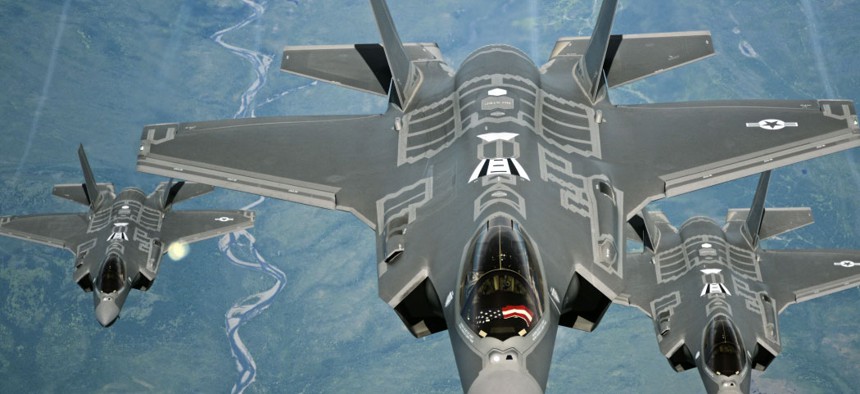Air Force says the F-35 is combat ready
The Joint Strike Fighter, the most complex and expensive weapon system in history, gets a green light from its biggest customer.
The Air Force this week declared that the F-35 Lightning II, one version of the most expensive weapon system ever, had reached initial operating capability, some 15 years after the Joint Strike Fighter program got underway.
The Air Force’s announcement that the fifth-generation fighter was “combat ready” follows the Marines’ declaration last summer that its version of the F-35 had achieved initial operational capability, but the Air Force announcement is significant because the Air Force is expected to use more that 70 percent of the U.S. component of the aircraft. In addition to the Marines, the Navy will use an aircraft carrier-capable version of the fighter, and some of the more than 2,400 F-35s will be used by coalition partners.
As a fifth-generation fighter, the F-35 is designed to be more maneuverable that previous jet fighters, better equipped to take out targets and, among other things, able to conduct electronic warfare operations to evade and defeat enemy air defenses.
The complexity of the on-board systems, which include more than 24 million lines of software code, has contributed to delays in the F-35’s production since the contract was first awarded to Lockheed Martin in 2001. In addition to working with the contractor, the Defense Department in 2014 brought in the Army Aviation and Missile Research Development and Engineering Center’s Software Airworthiness and Safety Lab to perform independent software safety analyses. Earlier this year, a defense official told Congress that engineers were fixing a glitch in a block of software that was interfering with the timing between the jet’s radar and main computer.
By declaring the F-35 operational, the Air Force is now taking a big step toward its next generation of fighters. “I am proud to announce this powerful new weapons system has achieved initial combat capability,” said Gen. Herbert “Hawk’ Carlisle, the commander of Air Combat Command. “The F-35A will be the most dominant aircraft in our inventory because it can go where our legacy aircraft cannot and provide the capabilities our commanders need on the modern battlefield.”
The F-35, which is capable of sophisticated ISR (intelligence, surveillance and reconnaissance) missions as well as strike capabilities, could also signal the transition into an even greater reliance on unmanned aircraft. Last year, Secretary of the Navy Ray Mabus said it will be “almost certainly will be the last manned strike fighter aircraft the Department of the Navy will ever buy or fly,” although some, particularly in the Air Force, disputed that assessment.
At any rate, the F-35 is expected to be around for a while, with a 55-year lifespan, and an estimated cost of $1.5 trillion over that time. And although costs have escalated during its development, it’s still expected to present something of a savings over the costs of have each service develop its own aircraft.
The Joint Strike Fighter has three variants: a conventional takeoff and landing version for longer runways that will replace the Air Force’s A-10s and F-16s, a short takeoff/vertical landing variant that will replace the Marine Corp’s F/A-18s and AV-8B Harriers, and a carrier version to replace the Navy’s F/A-18s. The Navy has said it expects to his initial operating capability for the F-35 by February 2019.




